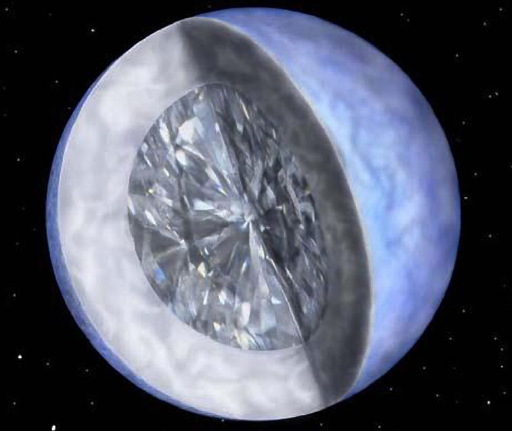The largest diamond ever found is not on Earth, but faraway across the galaxy.
It’s the burned out corpse of a star named BPM 37093 only about 50 lightyears away from Earth in the region of the sky we refer to as the constellation Centaurus.
The white dwarf star is a chunk of crystallized carbon that weighs 5 million trillion trillion pounds. That would equal a diamond of 10 billion trillion trillion carats.
Lucy. After it was discoverd in 2004, astronomers nicknamed the space diamond Lucy after the Beatles song Lucy In The Sky With Diamonds.
Lucy, also known as BPM 37093 and V*886 Cen, is the 886th variable star in the constellation Centaurus.
Star of Africa. By comparison, the largest such precious stones on Earth are the 545-caret Golden Jubilee Diamond and the 530-carat Great Star of Africa.
The Golden Jubilee Diamond was found in 1985 and is in Thailand’s Royal Palace as part of the crown jewels. The Great Star of Africa was found in 1905 and is in the Tower of London as part of the Crown Jewels of England.
White dwarf. A white dwarf is the hot cinder left behind when a star uses up its nuclear fuel and dies. It is made mostly of carbon and oxygen. and surrounded by a thin layer of hydrogen and helium gases.
The Sun’s diameter is 870,000 miles (1.4 million km). Lucy is tiny at a mere 2,500 miles (4,000 km) diameter.
The Sun is 109 times the diameter of Earth. Lucy is only about 2/3rds the size of Earth. That’s tiny for a star. However, Lucy’s mass is about the same as our Sun. That’s a lot of weight in a tiny ball.
While Lucy is a dead star now, it used to shine like our Sun. Lucy is very dim now, shining with only 1/2000th of the Sun’s visual brightness.
What is Lucy? Lucy is the most massive pulsating white dwarf currently known. Like other white dwarfs, Lucy probably is composed mostly of carbon and oxygen created by the past thermonuclear fusion of helium nuclei.
Lucy has a very thin atmosphere of hydrogen and helium. The atmosphere of our Sun is mostly hydrogen and helium.
Astronomers say that, similarly, our Sun will deplete its nuclear fuel and die in another five billion years, and then become a white dwarf like Lucy. Then, about two billion years after that, the cinder Sun will be a similar diamond.
How do they know? Astronomers had suspected since the 1960s that the interiors of white dwarfs would be crystallized and Lucy seems to confirm that.
In its death throws, the core of a star like Lucy or our own Sun becomes exposed and slowly cools down over time. Such a star begins to pulsate when the core surface temperature drops to about 12,000 degrees.
By comparison, the Sun’s core temperature now is about 27,000,000°F (15,000,000°C). Its surface temperature is about 11,000°F (6,000°C).
Lucy pulsates like a giant gong. Its internal pulsations are something like seismic waves inside Earth. Astronomers measured the pulsations to figure out Lucy’s carbon interior was solidified (crystallized).
Astronomers measured the pulsations hidden in Lucy’s interior in the same way geologists use seismographs to measure earthquakes inside Earth.
Where to look. Lucy is not visible from Earth with the unaided eye. It must be viewed with a telescope and is best seen from Earth’s Southern Hemisphere during March-June.
Source: Space Today

































Leave a Comment
You must be logged in to post a comment.